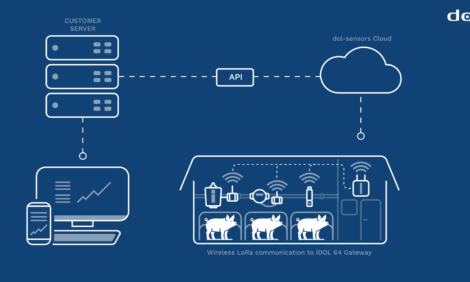



Living with Higher Feed Costs
By John Lawrence, from the June issue of the Iowa Farm Outlook of the Department of Economics of Iowa State University. Livestock producers are well aware that feed costs are higher than they were two years ago.The higher prices are expected to encourage increased world production of grains and oilseeds, but growing demand for food, feed, and fuel will remain strong. While we can debate what the new price levels will be, there is nearly universal agreement that higher grain prices are not a passing fad. Eventually, we expect for livestock and poultry prices to increase in response to the higher feed costs and reach a level that yields enough margin to sustain the industry. However, the transition may not be smooth or timely. The challenge for producers is to survive the short-term transition and prepare for long-run success.
Cattle and hog producers have had significant losses on animals sold since the fall of 2007. In addition to higher feed prices, there will also be greater grain price volatility. The loss of equity, higher input costs and price volatility lead to greater risk for producers. Short term survival and long term management in the future will require a review and possible revision both production and business practices.
The first step is to recognize that the world has changed. Strategies that worked well when corn was under $2/bu and was readily available may not work when its price is over $5/bu and may be difficult to buy when you need it. Second, implementation of changes in management and practices is important. Recognizing that things have changed isn’t worth much unless you adjust to the change. Put another way, how do you change your habits that were developed with feed costs were low. Many times the change needed is not a one time correction, but rather an ongoing practice that must be continued.
There are several other articles in this publication that address production practices for dealing with higher feed costs. I want to focus more on business management to address surviving in higher feed costs.
What will feed prices be?
Given enough time, more land will come into grain production world wide, yields will increase, livestock demand for grain will decline, and cellulosic ethanol production will be commercially viable filling part of ethanol demand. These expected changes in supply and demand will help moderate corn prices. However, in the coming year or two corn prices are expected remain near $5/bu for the 2008/09 crop year. This spring’s delayed plantings may push that number higher as will adverse weather during the growing season. A recent study by the Center for Agricultural and Rural Development (CARD) indicates that even a bummer crop would only lower crop year average prices to near $4/bu, but a sever drought could put average prices to near $8/bu.
This study reinforces two important management considerations. First do not wait for $2 corn, but rather anything near $4 will probably be a good purchase. Second, price may go very high if weather problems occur. Do you have a strategic reserve of corn to get through a period of very high prices or will you have to buy grain during these volatile times? Do you have borrowing capacity and storage to purchase some or all of your feed needs if the opportunity presents it self?
When will livestock prices adjust?
There are two ways that commodity prices can increase; higher demand or lower supply. Domestic demand depends largely on the price of competing meats, consumer income, and consumer preference. Rising feed costs has impacted all animal proteins so prices of competing meats are expected to be impacted somewhat similarly. Consumer spending is being negatively impacted by a weaker economy and rising gas prices and there is little indication that they prefer pork or beef more than they did before, all else equal. Demand also depends on exports and pork exports have been strong in recent months. Beef exports continue to grow slowly and there is hope that South Korea will be supportive for exports. After a slow start in 2007, pork exports have increased rapidly in since fall. At least a portion of the increased sales are likely related to the lower pork prices that occurred in October – March and may decline somewhat during the higher prices of summer.
Given the demand outlook, livestock production will likely have to decline to return to profitability to livestock and poultry producers at the higher feed costs. Liquidation of both the hog and beef cattle breeding herds has begun. Beef cow and heifer slaughter are higher than the year before. This adds to the current supply of beef, but will reduce supplies in the future. Higher pasture and forage costs and downward pressure on calf prices are squeezing cowherd margins will continue to encourage a reduction in cowherds. Lower placements of cattle into feedlots will reduce slaughter later 2008 and prices are forecast to be higher than we saw in the spring. However, sustained higher price levels will require further reductions cattle inventories.
By mid-May hog prices neared breakeven, but feed and total costs are expected to trend higher and prices are expected to decline again in the fall and red ink will likely return. The sow herd liquidation underway is expected to lead to hog higher prices in 2009. There is concern that the reprieve this summer may slow or stop the liquidation that is needed to return to profitable levels with the higher feed costs. Pork production from October 1, 2007 to mid-May 2008 was 10.1% higher than the same period the year before. Getting prices back to late 2006 – early 2007 levels will not be profitable in 2009. Export growth will help. The US exported approximately 15% of its production in 2007. Through the first three months of 2008 exports are 40% higher than the same period in 2007. If this pace is maintained, total demand will increase 6%. In addition, Canada has reduced its breeding herd. But, the bottom line is that the US will need to significantly reduce its breeding herd to achieve long term profitability. Some estimates predict a reduction of 10% or more is needed in the higher corn price era.
Managing risk
Grain prices will be volatile and sensitive to weather this growing season. Likewise, hog and cattle prices will be volatile as we move from high supplies to lower supplies. Exports, the economy, producer reactions to volatile corn prices will all impact these selling prices. Producers are encouraged to recognize these risks and focus on the margin between revenue and costs rather than simply prices. While opportunities will exist in volatile markets, it may be wiser to be more cautious in the months ahead.
Futures, options, forward contracts and livestock insurance products are tools that can help protect producers from significant shocks to their operating margins. Locking in an acceptable margin on at least a portion of your production may be a better strategy than hoping things work out for the best. If you are not familiar with these tools look for a opportunity to learn more about them a workshops and online seminars that are offered by Iowa State University, the Chicago Mercantile Exchange, Iowa Farm Bureau and others.
June 2008






